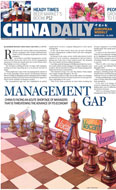Society
Japan radiation leak lower than Chernobyl
Updated: 2011-03-24 07:20
(Agencies)
VIENNA/OSLO - The release of two types of radioactive particles in the first 3-4 days of Japan's nuclear crisis is estimated to have reached 20-50 percent of the amounts from Chernobyl in 10 days, an Austrian expert said on Wednesday.
|
||||
On Tuesday, France's IRSN radiation protection and nuclear safety institute estimated leaks of radiation from the Fukushima plant crippled by the March 11 earthquake and tsunami represented about 10 percent of those from Chernobyl, the world's worst nuclear disaster, in 1986.
Comparisons are hard because Chernobyl's reactor blew apart, rather than leaking more slowly. Chernobyl's pollution blew over land in Europe while much of the contaminated air from Fukushima's crippled reactors has dispersed over the Pacific.
The Austrian institute's Dr Gerhard Wotawa stressed the two isotopes from Fukushima he had sought to estimate -- iodine-131 and caesium-137 -- normally make up only one tenth of total radiation.
Based on measurements made at monitoring stations in Japan and the United States, Wotawa said the iodine released from Fukushima in the first three-four days was about 20 percent of that released from Chernobyl during a ten-day period.
For Caesium-137, the figure could amount to some 50 percent.
The International Atomic Energy Agency said on Wednesday Japanese authorities had told the Vienna-based agency that radiation dose rates at the plant were decreasing, although the overall situation remained serious.
One U. study has estimated Chernobyl, in Ukraine, may over time cause 4,000 to 9,000 extra deaths from cancer.
And there are big differences in the handling of the crises.
"At Chernobyl, the population was not generally aware that the accident had happened," said Malcolm Crick, Secretary of the U.N. Scientific Committee on the Effects of Atomic Radiation.
"People in the nearby town of Pripyat were watching the fire from just a kilometre or so away. They were evacuated a day or so later," he said, adding that children kept drinking milk despite risks of contamination.
"In Japan, there was a precautionary evacuation early on," he said, adding "it's too early to make a real assessment of the overall impact." Japanese authorities also distributed units of stable iodine which can help protect against radioactive iodine.
Concern about Levels
Edwin Lyman, senior scientist at the U.S.-based Union of Concerned Scientists Global Security Program said the levels were worrying:
"The fact that radiation releases are approaching the level they did in Chernobyl is a cause for concern, a sign of the severity of the accident that's already taken place," said Lyman, especially given the way Chernobyl exploded.
"One has to remember that there's still no evidence that the containment structures of the damaged (Fukushima) reactors 1, 2, and 3 have been significantly breached, which is a difference from Chernobyl where the confinement structure was destroyed in the very early stages of the accident."
Wotawa said it was difficult to make day-by-day comparisons with Chernobyl, but he added: "For caesium and iodine ... the source terms (amounts released from the two accidents) are not so different."
He said iodine -- linked to cancer if found in high doses -- and caesium were both "volatile substances" which escape relatively easily when there are nuclear accidents.
Only minor traces of radiation have been detected in countries outside Japan, but the U.N. nuclear watchdog this week said "high levels of contamination" have been measured around the Fukushima plant, about 250 km north of Tokyo.
Japanese authorities advised parents on Wednesday not to let infants drink tap water in the capital because of raised radiation levels, and the United States became the first nation to block some food imports from Japan.
E-paper

Rise and shine
The Chinese solar energy industry is heating up following recent setbacks in the nuclear sector
Bombs aim for regime change
CSI, with a twist
Literary path
Specials

Peony express
Growers of china's unofficial national flower are reaching out to europe for help

Tea-ing up
More turning to Chinese tea for investment opportunities like vintage wine

A cut above
The ancient city of Luoyang is home to a treasure trove of cultural wonders.




